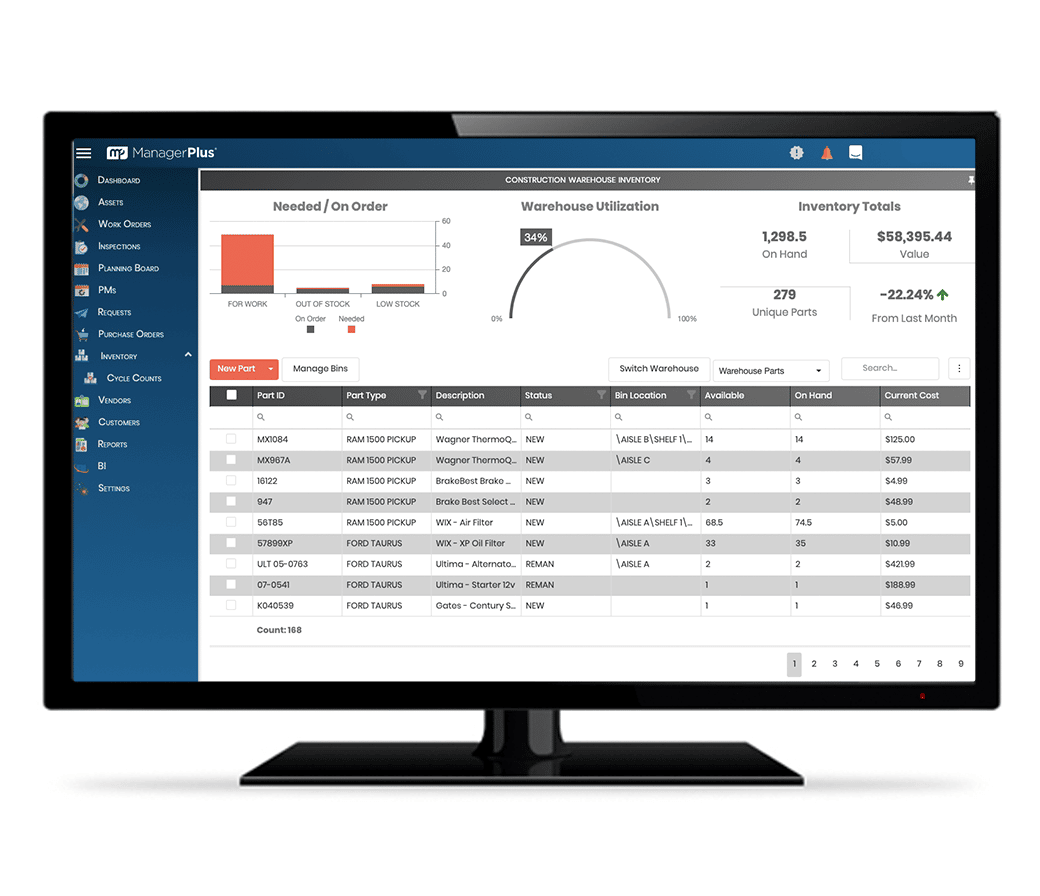Most companies have much more inventory in their warehouse than they actually need, making inventory often one of the largest costs for businesses.
Managing inventory properly ensures you’re not spending more than necessary on your maintenance, repair, and operations (MRO) inventory.
What is Inventory Management?
Inventory management is the point in the supply chain where your MRO inventory is tracked in and out of your warehouse. Inventory management focuses specifically on one particular piece of the supply chain with the goal of reducing costs, improving part availability, and boosting your ROI.
The gold standard of inventory management is to always have the right part, at the right place, at the right time, but the truth is that about 80% of MRO inventory goes unused every year, which means you’re likely holding on to a lot more inventory than you need.
Why is Inventory Management important?
A properly managed inventory is vital to the long-term success of any organization. Every business needs inventory to run their operations smoothly whether they’re a fleet of bulldozers or a production line spitting out widgets.
Some of the biggest costs related to poor inventory management are:
- Carrying costs
- Rush orders
- Missed fulfillment
- Equipment downtime
Carrying costs
Carrying costs are what it takes to hold onto inventory while it’s not actively being used. Once you’ve purchased it and it arrives at your warehouse, the cost to keep it on the shelf while waiting to be used are your carrying costs. Things like the rent on your warehouse, labor costs for taking counts, and the opportunity cost of not being able to store other things in that space all contribute.
It’s not uncommon to order parts from a supplier in bulk in order to negotiate a better deal. However, it all may actually end up costing you more in the long run than what you first paid for the parts. Most companies only use about 8-10% of their stored inventory on an annual basis, so getting a better handle on inventory management can save you quite a bit of money in the long run.
Rush orders
On the other side of the spectrum, not having inventory on hand when your technicians need it can lead to paying higher costs on rush shipping. A robust inventory tracking system can let you know when you’re running low on critical parts so you have plenty of time to order them before you need them.
Missed fulfillment
Whether your customer is an end-user or a supplier, you have people counting on your company to send them the products they need on time. Any time you have a missed shipment, for any reason, you have an upset customer. Sometimes this may mean you have to compensate them on another shipment to make up for it, or worse, losing the customer.
If you don’t stay on top of your MRO inventory, it can lead to repeatedly unplanned downtime which interrupts production. In addition to the monetary costs of missing a shipment, you can also suffer a blow to your reputation as a dependable company which is never a good thing. Inventory may seem like a small part of your maintenance operations, but it can have a huge impact on your organization.
Unexpected downtime
The biggest impact inventory can have on your asset management operations is unexpected equipment downtime. If your technicians don’t have the parts they need to repair equipment, it can start a snowball effect of increasing costs.
Always having the right part in the right place at the right time is vital to any successful preventive maintenance strategy. When you’re planning ahead for maintenance work, it’s important that you plan ahead for the parts you need as well.

Effective strategies for inventory management
Inventory management is only useful for your company if you know how you’re going to organize it in the first place.
There are several methods to effectively manage your inventory:
- Economic order quantity (EOQ)
- ABC analysis
- Just-in-time (JIT)
- Perpetual
Economic order quantity (EOQ)
This method is designed to minimize related inventory costs. It is essentially a formula to determine the ideal quantity you need to order for your inventory based on things like total cost of production, demand rate, and others.
With EOQ inventory management, you’re trying to minimize your purchasing as much as possible. It takes into account how many units you receive with each delivery and the carrying costs associated with them. You’re trying to find the balance between holding enough inventory to meet your needs with keeping your carrying costs as low as possible.
ABC Analysis
Another way to think about this is determining the criticality of your parts inventory. When you consider your assets and the MRO inventory needed to maintain them, you want to assign them either an A, B, or C based on how important they are to your operations.
“A” items are things that are vital to your operations. These can be parts for highly critical equipment that you can’t afford to be without. They can have an excessively long lead time, are one-of-a-kind items, or have an immediate impact on safety, the environment, or production. These are things that you must have on hand 100% of the time.
Items in the “B” category are things that would fall between the most critical and least critical items in your inventory. You don’t have to have them on hand all the time, but there are still important to your maintenance operations.
Everything else in your inventory can be labeled as “C” meaning they are things that you will need every now and then but aren’t very important to your overall operations. These might be items that have a very low carrying cost or are things you can wait to order until you need them.
Just-in-time (JIT)
Just-in-time inventory has been widely used across supply chains for many years as it’s a great way to reduce inventory costs. Instead of ordering too much ahead of time, JIT looks at how often certain parts get used and orders them so they arrive as needed. The goal is to avoid carrying costs and overstock. This system works well when you have a steady use rate, making it easy to estimate how much you need and when you need it.
Perpetual
Perpetual inventory management is the simplest strategy available as it is simply counting inventory as it arrives in your warehouse. It involves very little to implement and traditionally involves paper and spreadsheet records.
How to properly manage inventory
When it comes to managing your inventory properly, the first thing you need to do is audit what you currently have. You need to know what you have, where you have it, and which strategy you want to implement to manage it.
Once you’ve figured out what and where all your inventory is, it’s best to identify which parts are your more critical ones so you can make sure you prioritize them. One thing that can help you determine your most used parts is by looking over your maintenance history to see which parts are getting used more often than others.
Remember, about 80% of MRO inventory goes unused every year so auditing your inventory against your work order history is a great way to discover your excess inventory.
Most companies use inventory management software to help optimize their inventory operations. This software helps you track every item of inventory you have and keeps everything updated in real-time, so you always know where everything is.
Inventory management software as part of a larger enterprise asset management (EAM) solution is the best way to enhance your entire asset management operations.
With EAM software like ManagerPlus, you can automatically attach parts to work orders so as soon as a part is needed for a repair job, it’s automatically claimed and updated in the system. Even if the technician doesn’t pick it right away, it can’t be assigned to another work order, which means your techs don’t have to skip critical maintenance work because they don’t have the parts.
ManagerPlus lives in the cloud so all of your inventory data is always up to date. You don’t have to wait for someone to enter anything into the system or go check the bins before you generate a work order. With one click, you can instantly see what you have, and what you need more of.
EAM software also keeps a historical record of all your work orders and the parts that were used which you can use to generate reports to see where your inventory budget is going. You can easily see what parts you’re using more frequently and can make informed decisions on purchasing stock.
How to get started
The first step to optimizing your inventory management is to talk to an expert. Our specialists are ready to help you take control of your inventory management so you can start cutting costs and improving your ROI.
What did I miss?
Inventory management is vitally important to the longevity of any organization. Most companies are carrying much more inventory than they need and are spending more than they should on inventory.
Some of the most effective strategies for managing inventory are:
- Economic order quantity (EOQ)
- ABC analysis
- Just-in-time (JIT)
- Perpetual
Adopting inventory management software is the most effective way to discover which strategy is best for your organization and implement it effectively. Using inventory management software as part of a larger enterprise asset management (EAM) solution can help you optimize your entire asset management operation.
Schedule a live demo of our software to see it in action for yourself.


